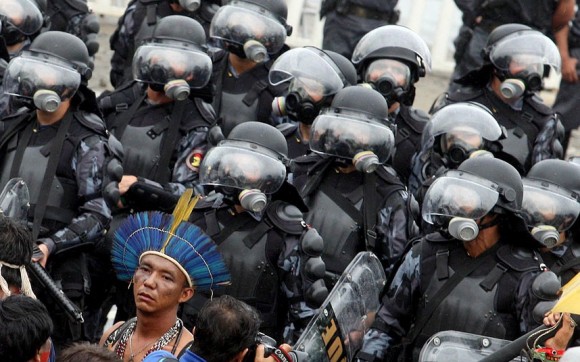 Assessments of the Rio+20 Conference have been appearing since the conference ended on 22 June. They are every bit as bleak as could have been imagined from the discussions leading up to the conference.
Assessments of the Rio+20 Conference have been appearing since the conference ended on 22 June. They are every bit as bleak as could have been imagined from the discussions leading up to the conference.
The Rio+20 Earth Summit was supposed to be a triumphant follow-up to the Earth Summit that took place 20 years ago in Rio, a summit at which three three significant conventions were adopted on climate change, biodiversity and desertification. Despite the lofty ambitions to address anthropogenic climate change that these treaties articulated, the record since their adoption has been a dismal one. Since 1990, yearly emissions of carbon dioxide have increased 45 % and soon the atmospheric concentration will pass 400 ppm, a stark contrast with pre-industrial rate of 280 ppm. The contemporary extinction rate of species is also alarmingly high with some 30 % of amphibians, 21 % of birds and 25 % of mammal species at risk.
Yet if the original Rio conference has proven to be insufficient to address the climate crisis, its successor last month was nothing short of a full-scale capitulation to the forces that are wreaking havoc on the planet. The vacuousness of the official documents emerging from Rio+20, including the capstone report The Future We Want, is caught with withering scorn in an article by George Monbiot. In his assessment of the conference, Monbiot traces the shift from (vague) notions of sustainability that world leaders signed up for at the original Rio conference, to sustainable development, a concept promulgated in short order following the original conference, to sustainable growth and, in the 2012 Rio+20 text THE FUTURE WE WANT, sustained growth.
As Monbiot notes, “if sustainability means anything, it is surely the opposite of sustained growth. Sustained growth on a finite planet is the essence of unsustainability.”
 On this score, the Rio+20 declaration is filled with empty platitudes promoting harmony with nature. There are no specific regulatory mechanisms or concrete timetables included in the official Rio+20 documents. In fact, through its overarching focus on the green economy, the conference foregrounded capitalist market-based solutions – such as REDD – that are the source of the problem. As Rikard Walenius puts it in a recent article assessing the Rio+20 conference:
On this score, the Rio+20 declaration is filled with empty platitudes promoting harmony with nature. There are no specific regulatory mechanisms or concrete timetables included in the official Rio+20 documents. In fact, through its overarching focus on the green economy, the conference foregrounded capitalist market-based solutions – such as REDD – that are the source of the problem. As Rikard Walenius puts it in a recent article assessing the Rio+20 conference:
While never clearly defined, green economy usually refers to attempts at “internalizing the environmental externalities” through the objectification and commodification of ecosystems (reduced to their “environmental services”). These newly minted services can then be bought, traded or securitized as any other financial commodities. Experience so far implies that such market-based solutions have weak environmental impacts but strong social impacts. Evaluations of the the CDM market, part of the carbon trading scheme of the Kyoto protocol, reveal that between one and two third of the projects do not deliver the promised emission cuts. In Africa, India and other parts of the world, poor rural dwellers are those most dependent on the free “services” – e.g. fresh water, food, firewood, medical plants – that the natural commons provide. Payment schemes may perhaps slow down deforestation at a high social price, but the “avoided emissions” are then traded and exchanged for continued emissions in a developed country. In this way, financialisation often means zero gains for the environment but a de-facto transfer of rights and properties from the poor to the rich. Essentially, it provides a way for those who can afford it to occupy double the environmental space, as they can continue emitting, while assuaging their guilt through “green consumption”.
Rebuttals of the CDM market are legion, but Carbon Trade Watch’s recent report, Green is the Color of Money, which exposes the failure of the European Union’s Emissions Trading System, is a particularly damning indictment of the green economy rhetoric that dominated official circles at Rio+20.
As has been true in previous climate conferences, Rio+20 also provided an opportunity for grassroots climate  justice movements to network and flex their muscles. As the gridlock at the top worsens, these movements become increasingly important through their articulation of non-market based, genuinely sustainable alternatives. Indigenous protest figured particularly prominently at the People’s Summit in Rio, as the photographs included with this post suggest. As Windel Bolinget, of the Cordillera People’s Alliance in the Philippines, put it:
justice movements to network and flex their muscles. As the gridlock at the top worsens, these movements become increasingly important through their articulation of non-market based, genuinely sustainable alternatives. Indigenous protest figured particularly prominently at the People’s Summit in Rio, as the photographs included with this post suggest. As Windel Bolinget, of the Cordillera People’s Alliance in the Philippines, put it:
When we look at the policy proposals of the draft document drawn by UNEP, basically the green economy is converting nature as a capital, so it is basically the commodification of nature – our carbon credits and eco-system. The corporations are to make cash value off these investments. It does not address the root causes of climate change such as nuclear power, extractive industries, the polluting of rivers and [the destruction] of our mother Earth.
An article by Preethi Nallu summarizes the interventions by indigenous groups, women’s organizations, and other grassroots activists at The People’s Summit in Rio. As has been true of People’s Summits held at previous climate conferences, such as COP17 in Durban, these alternative voices tragically made virtually no impression on the myopic global leadership who gathered in official venues to fiddle while the planet burns.
As has been emphasized repeatedly by activists, we have the solutions to the climate crisis. All that is lacking is the political will to implement such solutions. A dossier published by leading academic activists to coincide with the Rio+20 conference underlines this by focusing on genuinely sustainable solutions in areas such as food sovereignty, sustainable cities, oceans, and decent jobs.
Faced with the inaction of elites and resulting environmental and social cataclysms, the movement for climate justice must stress the fundamental power imbalances that lead to carbon colonialism. As the climate crisis hits home, the movement’s analysis of the political ecology of global warming cannot but resonate with more and more people. In such conditions, the movement’s awareness of sustainable alternatives can play a crucial role in repudiating current unsustainable models of ceaseless commodification and endless growth. Climate Justice Now!